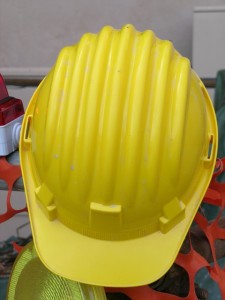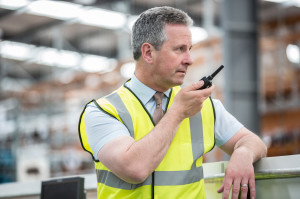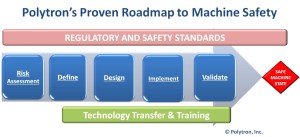 If you are a bottom line type of person, you should know that your business’ greatest asset is its employees. They can also be an expensive liability. Research has shown a direct correlation between safety and productivity. When safety performance is increased, operational performance, machine speed, and utilization increases as well – as much as five to seven percent higher OEE and two to four percent less unscheduled downtime.
If you are a bottom line type of person, you should know that your business’ greatest asset is its employees. They can also be an expensive liability. Research has shown a direct correlation between safety and productivity. When safety performance is increased, operational performance, machine speed, and utilization increases as well – as much as five to seven percent higher OEE and two to four percent less unscheduled downtime.
If a machine breaks, you need someone to fix it. But, if a person is hurt or killed on the job, there is downtime, loss of man hours, a payout for compensation and recovery, OSHA fines and possible legal action. Businesses spend $170 billion a year on costs associated with occupational injuries and illnesses – expenditures that come straight out of the company profits. And, lost productivity from injuries and illnesses cost companies $60 billion each year. Safety programs aren’t just a cost; they are an investment and an insurance policy.
A Safety Risk Assessment
Your company may have had an Environmental, Health and Safety (EHS) program in place for years or be in the early stages of the process. Regardless of the title or size of your program, the program is designed to address workplace safety and health hazards on an ongoing basis. One of your most important goals is likely: Eliminate or reduce the chance of error or injury when employees work with heavy, high-speed manufacturing tools, and high voltage equipment. Where do you start?
One of the first steps in executing your safety strategy is to identify the potential hazards that currently exist. This covers anything from oil or water leaking in walkways to warehouse shelving hazards. This step is typically an internal audit-level exercise or risk assessment conducted by evaluation of various historical incident metrics in all areas of the manufacturing facility coupled with the company’s safety strategy. The company establishes tolerable ranges for risk and assigns these values to machine hazards throughout the facility. As part of your safety program strategy, an acceptable risk value to be achieved through mitigation is also assigned. The risk assessment is the most fundamental component of any machine safety project, and is referenced regularly throughout the life of your company’s safety program. It is this document that provides the overall safety project roadmap to be followed by engineering solution providers like Polytron.
The root cause of productivity loss often points back to an unsafe machine state. With almost 75% of U.S. manufacturing facilities more than 20 years old, there are a great number of older machines still in use in the United States. This means that many machines do not have the proper guarding, controls or utility systems to meet today’s safe machine standards and most of the original equipment manufacturers do not support upgrades to achieve a safe machine state.
Just as with any investment, you may want to diversify your machine safety upgrades while meeting the objectives of your EHS program. Some companies apply a strategy of immediate machine safety projects based on risk rating. The higher the risk, the more immediate mitigative action is taken.
Implementation and Training
Once equipment safety updates and modifications are made to reduce all identified hazards, the equipment is like a new piece of machinery — safety-rated components have been added, technology and software integrated in machine operation and isolated safety zones have been created. Training employees how to operate and maintain the “new” equipment is critical to everyone’s safety and operational improvement.
Our proven roadmap (below) outlines our approach to machine safety beginning with the first step of a risk assessment. As shown on the roadmap, a definition of how to address the hazards is developed; a detailed definition of the solution, which includes the scope, preliminary hardware and software, budget, preliminary schedule and training, is developed applying all applicable regulatory and safety standards; once the definition is approved by all stakeholders, the design specification is developed which shows all safety equipment, software and hardware to be applied and any machinery changes to be made; the design is implemented; and then every element of the newly designed safety technology is tested and validated.
Risk mitigation creates necessary change for everyone’s protection and in many cases, provides operational improvement. As a critical part of the Machine Safety Roadmap, we develop a specific Technology Transfer and Training plan to ensure that any worker involved with the operation of the newly upgraded machine is properly trained on the new changes that have been made. In other words, we approach the upgraded machinery as “new equipment”. Without training, the operator would continue to shutdown the machine as before, creating unnecessary downtime and creating unsafe actions. With effective training, the upgrades, and a retrained workforce often times delivers greater productivity than before the safety upgrade.
In a Polytron Safety case study addressing a high risk palletizer, the safety project delivered overall productivity improvements such as: Increased uptime by 14 percent to 21 percent; incorporate speed improvement for increased throughput; made controls more operator accessible increasing safety and increased availability to diagnostics.

Developing the plan: After the first steps have been taken, a full plan is developed which outlines the specifications, behaviors and measurement criteria for the company. These plan items include:
- Safety Rules
- Employee Responsibilities
- Safety and Training
- New Employee, Contractor and Visitor Orientation
- Incident Investigation and Reporting
- Personal Protective Equipment
- Emergency Action Plan
- Safety Discipline (violation policies)
- Employee Confirmation of Safety Program
A culture of safety doesn’t just have an impact on accident reduction, it also has an impact on the entire manufacturing process. Some manufacturers run for years without an incident because of their safety culture. They are the best in the industry not only for their safety, but because of their resulting efficiency. Manufacturers with a safety culture have less turnover, less absenteeism and higher productivity. Establishing safety and health management programs can reduce your injury and illness costs by 20 to 40 percent. In today’s market, that could mean the difference between thriving or surviving. (OSHA, Safety and Health Add Value)
Creating a Culture of Safety
Providing a safe work environment for your employees, contractors and visitors starts with a Vision and Mission. Simply stated, “Every worker has the right to go home safe and healthy everyday and every employer has the responsibility to provide a safe work environment.” This was the driving force that resulted in the passing of the Occupational Safety and Health Act of 1970 (OSH Act) or OSHA. The law was created to set and enforce protective workplace safety and health standards. And its Vision is to significantly reduce safety and health hazards in the U.S. workplace.
Many companies with a safety culture, create Vision statements to drive safety from the top down. Examples are, “Our Vision is to have colleagues, contractors, and visitors return home safely at the end of each day”, “We have the right to work in a safe environment”, “We will provide the leadership necessary to create a culture in which all employees accept personal responsibility for workplace safety and health”, “We are committed to providing a safe and healthy workplace for our employees…”.
(1) A Safety Mission/Values statement – which means the Principles we live by -, and (2) a Safety Program – which set our engagement rules. These beginning steps are generally driven by the executive office along with the Environmental, Health & Safety officer or Human Resources. It is designed to be woven into the very fabric of the organization, whether on the plant floor or in administrative offices – it is for everyone that conducts work on behalf of the company, including temporary workers.
Safety and Health Principles should be established. A sample list might look like:
- Provide workers with a safe work environment.
- Demonstrate that work is never so urgent that we cannot take time to do it safely.
- Demonstrate alignment with the safety mission in both words and actions.
- Ensure accountability at all levels of supervision for safety performance.
- Provide on-going property conservation practices.
- Provide Personal Protective Equipment.
- Develop and implement safe work procedures and rules.
- Encourage raising concerns about hazards by everyone.
- Provide ongoing safety training.
- Conduct routine/regular workplace inspections.
- Enforce safety rules and appropriate discipline.
- Include safety as a performance measurement for all employees.
To build a Safety Program focus on the three supporting areas of Prevention, Capability, and Compliance.
- Prevention gives us insight into setting a prevention goal that can be achieved based on basic safety changes, procedural changes, and the more in-depth habits and technologies. Implementing easy to follow policies and hazard prevention are key concepts.
- Capability proved to be the biggest surprise to the representatives as they gained an understanding in passive awareness, pro-active engagement, and skill-driven engagement. Culture change starts with orientation and continues with formal and informal training opportunities, and employee driven awards that focus on catching someone in the act of “doing something right” rather than the “number of accident free days”.
- Compliance focuses on benchmarking and leveraging internal and external best practices, providing easy access to safety requirements and having simple auditing and tracking methods in place.
Getting Employees Involved
The biggest hurdle in starting a culture of safety is getting everyone to buy into the idea that safety is an investment with real bottom-line benefits. Myths, stories, attitudes, norms, assumptions and beliefs all stand in the way of getting the acceptance facilities need in order to develop a culture of safety. Signs, billboards, reports and incentives can also help, but in the end, the people who run the business will be your greatest asset if they know how to ensure each other’s safety. Safety systems can be as simple as including safety conversations in existing meetings and a comment box, but no safety system will be successful without universal buy-in. Safety brings organizations together because everyone can work toward a common goal and improve a business’ bottom line. To successfully improve a facility’s safety record there needs to be support from leadership, shared responsibilities, clear communication and continuous improvement. Everyone has to take responsibility, but the trend starts with management. If leaders don’t demonstrate an active commitment to safety, nobody will.
Supporting Change for a Culture of Safety
To get through the initial barriers, personnel should understand why they are being asked to change what they normally do and trust in their leadership to follow through with support. Employees need to know that if they take action or speak up, that they will be rewarded, not punished for their action. There needs to be consistent support and positive reinforcement from leadership.
Safety should be part of the operational fabric of a facility. That means doing things like discussing safety at the start of meetings and holding leaders accountable for safety performance. Additionally, these measures might also break down organizational barriers such as fear and lack of trust. Employees should still use the chain of command, but they shouldn’t have to face repercussions for speaking up. Supervisors and managers should be held accountable for their responsiveness when issues are raised.
Communicating Safety
Changing organizational behavior is the goal of creating a culture of safety. The continued success of a safety program hinges upon everyone’s ability to clearly communicate their thoughts and intentions and act accordingly. Clear and constructive safety communication improves understanding, prevents at-risk behaviors and enhances safe work practices. A Plan to Act can provide the procedures personnel should follow when they encounter an unsafe scenario. Leadership’s directives, guidance and training shows the committees what the right decisions are and how to make the right decision when individuals recognize and unsafe scenario. Leadership is also responsible for Safety Committee oversight. Safety Committees should be composed of production teams, managers and supervisors who can ensure responsibilities are distributed among everyone. A Safety Committee promotes safety awareness and reduces the potential for injury/loss at all levels of the company. The committees hold individuals accountable for meeting the goals outlined in Safety Reports.
Formalizing a Safety Plan
A safety program should start with a risk assessment of all equipment in the facility, using a standardized method and data capture tool to ensure that all machines receive the same review and that no item is left unchecked. Risk levels are then assigned to the assessments based on an agreed upon risk hazard rating. Once the risk levels of each piece of equipment in the plant has been established, a remediation plan can be developed based on the highest to the lowest risk machinery.
Safety goals should be clearly defined within safety reports and since committees and reports help to provide the organizational structure necessary for improvement, the reports need to be substantiated with accurate data. Overemphasis on bottom line performance, such as the accident rate, can drive accident reporting under the table. Reporting minor incidents and near misses requires additional training, attention and time for input. As a result of more in-depth, accurate reporting, incident rates will appear to rise initially, but it will level off and decline as safety system changes take hold. Accuracy in reporting is important because OSHA violations can carry serious consequences.
“Establishing safety as a value rather than a priority tells our employees and our customers that safety is built into our culture, not something we do to merely comply with regulations.” Source: National Safety Council
What this means for these manufacturers is that OSHA will show up unannounced and conduct a comprehensive wall-to-wall inspection of the facility in their jurisdiction. Why? This is a local enforcement strategy addressing industries that pose a particularly high risk to workers. This differs from an incident inspection where OSHA is only interested in the area involved with the reported incident or hazard reported by a worker. Letters of inspection notification have already been sent to the auto parts manufacturers and the inspections are underway and will continue through 2015.
You might be thinking, “but, we are not an auto parts manufacturer. It doesn’t impact my plant.” The discussion is broader in scope than the targeted actions being taken by OSHA in the automotive parts industry. It is an awareness that as an employer, you have a responsibility to provide a safe working environment for your employees, contractors, temporary workers, and visitors. Many of the OSHA Local Emphasis Programs (LEPs) are focused on specific equipment such as powered industrial trucks or hazardous respiratory conditions like breathing silica dust, and these programs cross many industries.
If OSHA Knocked on Your Door – Are You Ready?
A good starting point for your company, might be to ask, “Are we aligned as an organization for safety standards, communications and training?” If the answer is not a 100% “Yes,” then this the opportunity to make a commitment to safety at the highest level of the company. In a previous blog, I talked in detail about creating a culture of safety for your organization and it helps you prepare as an organization to establish and launch a safety program.
What are some of the signs that an operation may not result in compliance?
- Lack of continuous emphasis on safety
- Wages paid to injured workers for absences not covered by workers’ compensation
- Wage costs related to time lost through work stoppage
- Administrative time spent by supervisors following an injury
- No formal employee, contractor, visitor and temporary worker safety training program
- Lost productivity related to new employee learning curves and accommodation of injured employees
- No Risk assessments on equipment and work areas
- High replacement costs for damaged material, machinery or property
Review OSHA’s 2013 Top Ten Citations (in order of total number of violations) which touches just about every corner of the manufacturing floor. Has your facility experienced injuries or near misses in any of these areas? HaVE preventive measures been taken to ensure it is no longer a hazard?
- Fall Protection – General Requirements (1926.501): Total violations: 8,241
- Hazard Communication (1910.1200): 6,156
- Scaffolding (1926.451): 5,423
- Respiratory Protection (1910.134): 3,879
- Electrical – Wiring Methods (1910.305): 3,542
- Powered Industrial Trucks (1910.178): 3,340
- Ladders (1926.1053): 3,311
- Lockout/Tagout (1910.147): 3,254
- Electrical – General Requirements (1910.303): 2,745
- Machine Guarding (1910.212): 2,701
OSHA’s Focus in 2015
 OSHA will shift focus from time to time based on season, increase in incidents in a specific industry, and programs specifically designed to decrease workplace fatalities, injuries and illnesses.
OSHA will shift focus from time to time based on season, increase in incidents in a specific industry, and programs specifically designed to decrease workplace fatalities, injuries and illnesses.
Currently, the focus list covers:
- Workplace violence
- Falls
- Heat Stress (because of the summer months)
- Whistleblower protection
- Incentive Programs
- Temporary workers
Heat Stress Hazards
In certain parts of the country, temperatures reach into the 100s during the summer months. Without the proper care and training for employees, heat stroke and exhaustion causes an increase in deaths during this time period. Employers have the responsibility to provide WATER – REST – SHADE to protect workers. Even inside in some manufacturing, warehouse and distribution facilities, temperatures rise and the same heat stress hazards exist
Temporary Workers
This is a new focus by OSHA. Incidents of temporary workers has risen often due to a lack of adequate training, language barriers and the fact that a temporary worker will often not refuse to carry out a task in order to keep the job.
When employees are new on a job, they are at an increased risk for injury because of no experience. Without proper training, the temporary worker will not be aware of the hazardous conditions when working around manufacturing equipment and powered industrial trucks. OSHA has launched an initiative, using enforcement, outreach and training to ensure that temporary workers are protected from workplace hazards.
Maintain a good communication between the staffing agency and your company on the job hazards and assignments versus “send me some workers”. Many staffing agencies are now being cited along with the manufacturing company because they hold a responsibility in managing the safety of their workforce as well. The staffing agency should provide an overview training on the hazards that workers will find at the job site, along with what is required by Hazard Communications.
Your responsibility is to train temporary workers on specific job hazards, protective measures and safety requirements at the job site. Remember that when temporary workers arrive onsite at your facility – they are your employees and should be managed and trained the same way as a permanent worker.
Safety and Health Programs DO Work
OSHA cites several proven benefits by implementing and building a Culture of Safety:
- Transforms workplace into a Culture of Safety
- Reduce injuries, illnesses, and deaths
- Lowers workers’ compensation and other costs
- Improves morale and communication
- Enhances corporate image and reputation
- Translates to better processes, products, and services.
Continuous Improvement
The start of a safety program often leads to major improvements, but after a period of time, progress can stall. Incentives, continuing evaluations, committee changes and consistent reinforcement from leadership ensures that a facility is committed to a culture of safety.
Publicizing results will help sustain efforts and motivate employees. Recognizing and rewarding safety performance shows employees taking action on safety procedures will lead to good results. You can also use a stick to punish bad results. Charging costs back to the unit that incurs them is a strict system of accountability. Individuals who can be rewarded and penalized for safety measures will be much more willing to confront unsafe behaviors or conditions and address them, or even shut them down until corrective measures are taken.
Through self-guided safety checklists to specialized training programs, Polytron can help you transform your workplace into a Culture of Safety that exists beyond an aging workforce.




